Going Big: How the East’s largest human-made surf spot came to be in this exact, undoubtedly surreal location
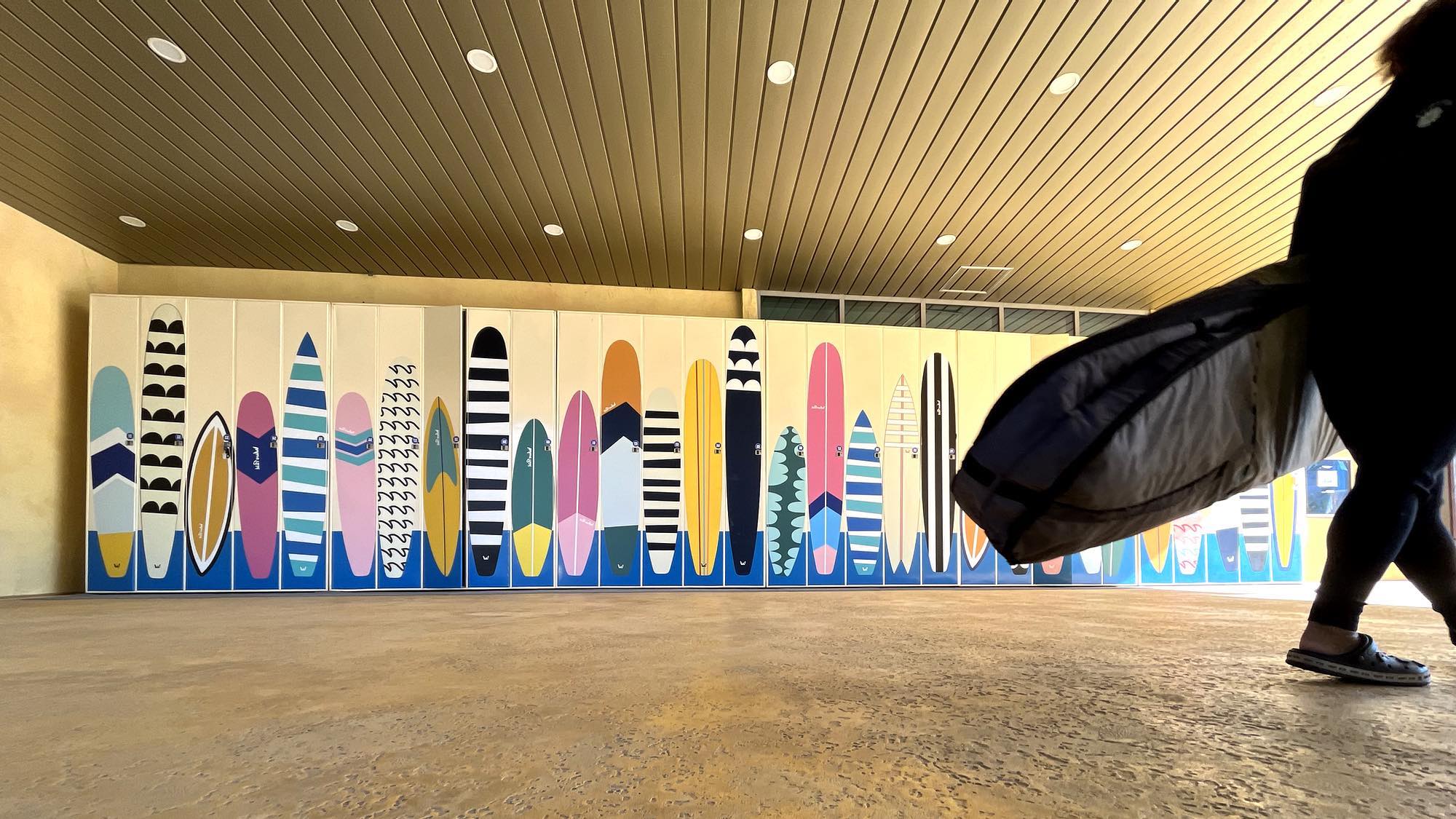
Surfing is young in South Korea. It’s only been in the past ten years that interest has flourished. When considering cultural norms and geography, it makes sense. The peninsula country is surrounded by less-than-ideal swell-generating seas.
In late 2022 WavePoolMag set out to surf the world’s largest Wavegarden Cove here. The surf park sits in Siheung-si in an unremarkable industrial zone across from Incheon. The area is fashioned on neatly squared sectors of landfill and dotted with lego-perfect high-rises-in-the-making. Construction noise is the official soundtrack to this area, kicking off at 6am and stopping 14 hours later.
They work fast here. I remember seeing early pictures of the 56-module Cove design just three years ago. Long, peeling waves set against an empty skyline cut by the occasional construction crane. Today on my visit, that same background is filled in with newly minted buildings.
The surf park itself feels like an amusement park complete with mascots (cast in fiberglass throughout the grounds), a giant video screen replaying rides and loudspeakers pumping out the official Wave Park theme song between announcements in four languages. It is the polar opposite of The Wave Bristol’s curated earthiness.
But why build Wave Park here? That was a question we kept asking. Luckily, we met someone who was part of this wave pool’s coming-to-life story.
Euna Kim is a young professional from South Korea. She did marketing and translation for Wave Park and has her hands in theme park publications, translation, media and more. At a personal level, her Instagram feed makes paid influencers jealous – lunches in Thailand, drinks at the foot of the Eiffel Tower and surf checks in Melbourne. Somehow, Euna stayed put long enough during our visit to tell us the story of how Wave Park came to be in this exact spot.
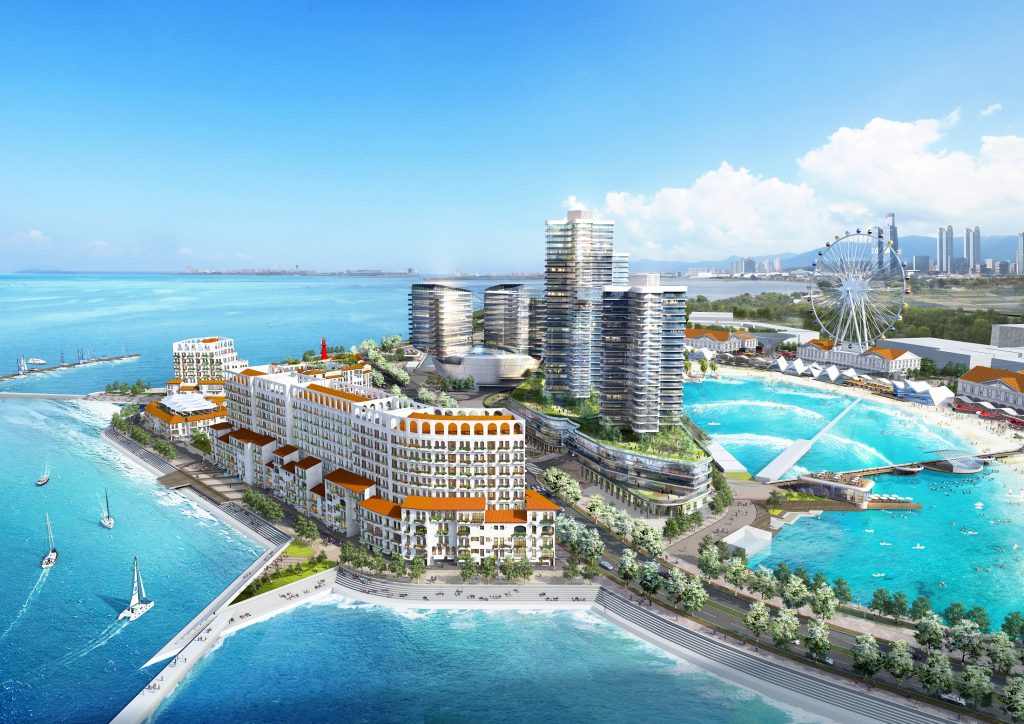
Can you give us some background about how you got involved?
I was working for the for the Wave Park at their headquarters, which is the Daewon Plus Group. So that was the very beginning of the project, and I was involved because it was my role within the company to talk to Wavegarden.
What was the first step?
So first thing was, we were looking for land for this huge wave pool. Then finally we found Turtle Island. So we had a talk with Wavegarden. The company was also at the beginning of its business. They didn’t really have their commercial sites opened up yet. So I think it was our Korean team to enter the first contract with the company.
How did the early process work?
We visited the demo facility at the San Sebastian headquarters. We rode the waves and it was all very impressive. But we wanted something bigger – the biggest in Asia. That’s why how our project got to be so big. We said ‘okay, the reef is enough for 20 surfers, but we want the bay section to be much bigger.’ Because in Korea, we don’t have that many surfers, so we have to bring more beginner surfers into the pool to grow the base of surfers. So we asked them to enlarge the bay areas. That’s when our project became huge and the investment amounts got higher. And the time period also became longer. That was the most challenging thing at the beginning, all the details in making such a large pool and knowing if it’s possible.
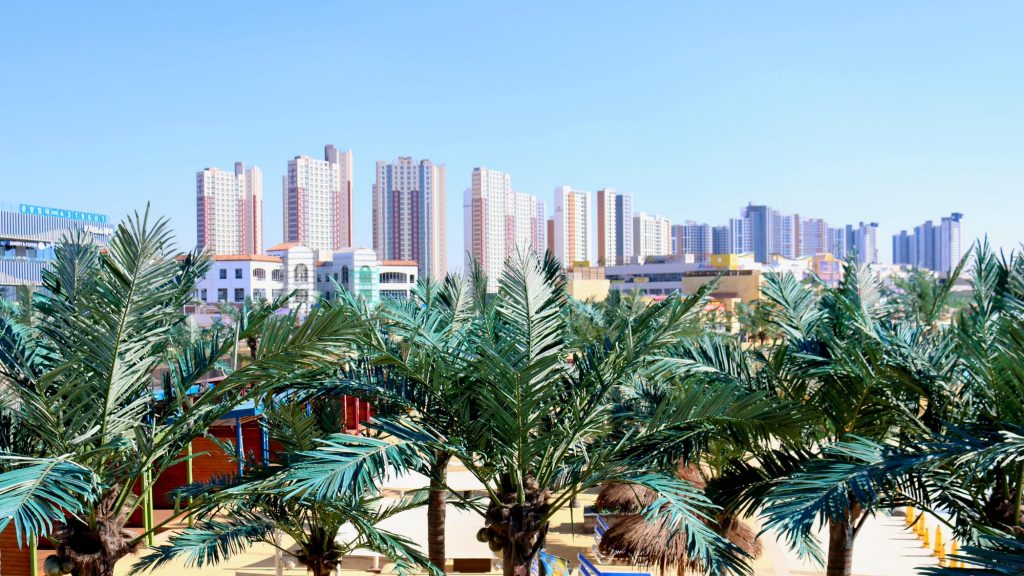
What was the process like? To bring the wave pool here, you worked extensively with Wavegarden.
So the first thing is you have to have trust between the two companies. They didn’t know our company. And we also didn’t know them and the only wave pool they had was Surf Snowdonia, there were no full-size Coves yet. We hadn’t seen if it is successful or not. They said they were signing contracts with Australia but we didn’t see the actual pool yet. For our part, our company was already doing well by building residential buildings only. But then they decided to expand their business to include a theme park and wave pool. In this way, we were expanding our business to more areas.
How did that early relationship solidify, so that there was enough trust to build Wave Park?
We invited Fernando Odriozola to Korea to look around at our business so he could see that we are doing well. We did that several times. And we went to Spain. They came to Korea. And so on. Then we finally grew that trust. And then we said, okay, it’s time to sign a contract. So that’s also when we found the right place to build this pool.
And tell me about this area Sihueng-Si, because just a few years ago, it was still factories. Now all the buildings here are new. How did it come about that this is where you decided to build?
The first potential site was not here. Actually, it was in in the city where our company is headquartered, in Busan which is really popular for tourism. They have beaches and they also have a lot of tourist attractions. So if we built the wave pool in Busan, we would ensure that people would come because we also have beaches for surfing. But there were some problems with the municipality. They didn’t allow us to build the wave pool. They didn’t have a buildable site. That’s why we looked for other sites all over the country. Then finally we found a place here in, Sihueng-Si. So at the time, it was just a vacant area, but if we wanted to build, we’d have to develop the whole area because this is not really a popular destination. So they told us that if you take this land, you’ll have to be responsible to develop the entire city.
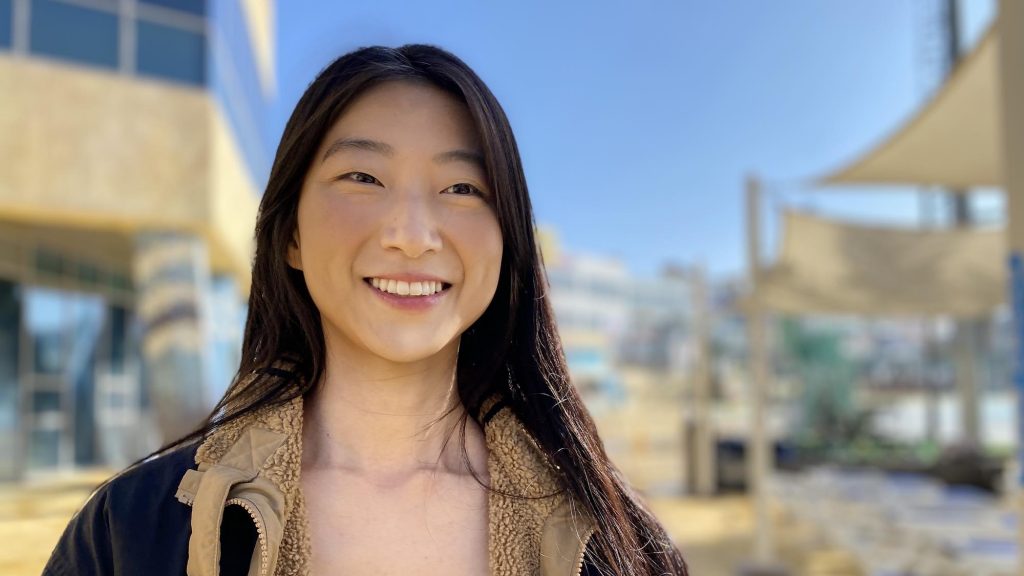
So all of these high-rises popping up overnight are part of the wave pool deal?
Yes. That’s why we can’t just make the wave pool here. We also have to make hotels, residential areas and all the infrastructure to bring in stores and restaurants.
So how would you describe this area right now? It doesn’t really look finished.
No, it’s not really finished. A lot of buildings around here are half-empty. But what will this look like in a few years? Two years? Five years? We’re looking at five years to complete all these hotels and buildings.
Who will come here? Is it mostly people from Seoul?
We are expecting people from all over the country, but there’s still the issue of getting here. So traveling is troublesome from other cities. But thanks to the new roads and infrastructure and also proximity to the capital. We are expecting more and more people to come.
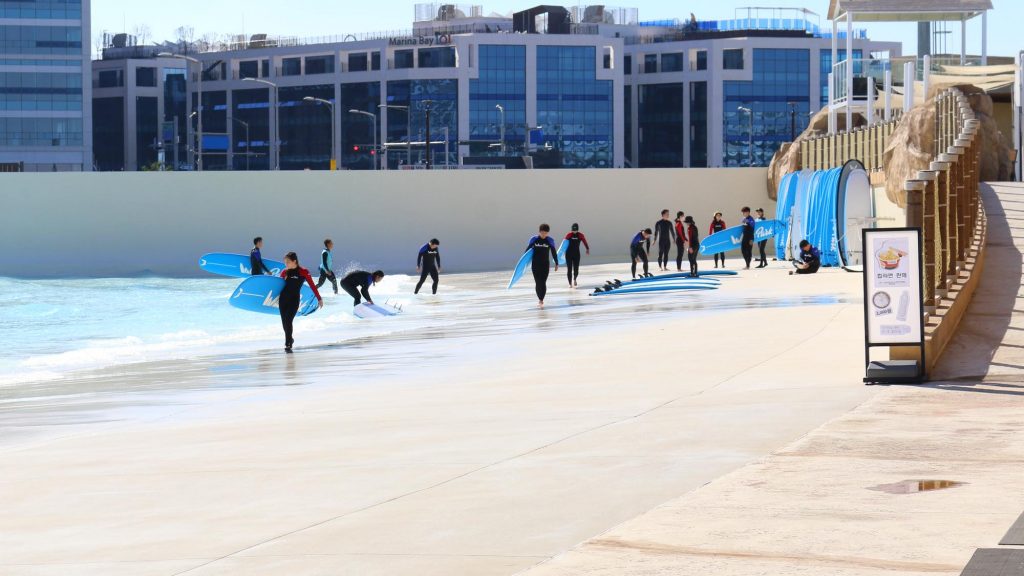
What are some of the cultural blocks to surfing in Korea? I heard a story about how people would go to the beach, but not go into the water. Do you see Korea changing?
Yes, I can see it changing. It already is. Not just surfing, but like kitesurfing. Kite and some other water activities are increasing. And now they’re doing more water activities for the young kids. But before, if you think of water activities in Korea, we only think of swimming. And that’s swimming not in the ocean, but in the pool. Most Koreans only swim in the pool, not in the ocean.
So what would a beach day in Korea look like?
Growing up we’d go into the ocean with a floaty tube – just tubing and floating around. But we didn’t actually swim or try to do anything like catching waves. I don’t know why, but we only thought about playing at the beach in one specific, designated area.
What are some of the challenges to creating a tourist destination?
To make an area popular for tourists, the brand of the city is important, like a name brand. So Busan is very popular in Korea. Everyone knows Busan. So if you are doing something in Busan, you’ll be more successful than if you do it here. Before we started this project. I had never heard of this city. It was not popular. It’s very small and it’s at the end of the West Coast. So no one knows it. It was only factories. So the tourists never came because there was nothing to see. That’s why Wave Park wasn’t very popular at the beginning. We promoted the brand on Instagram and YouTube, but people didn’t know where it was and had never heard of it. So, yeah, that was always a problem to address. And now people are starting to recognize it.
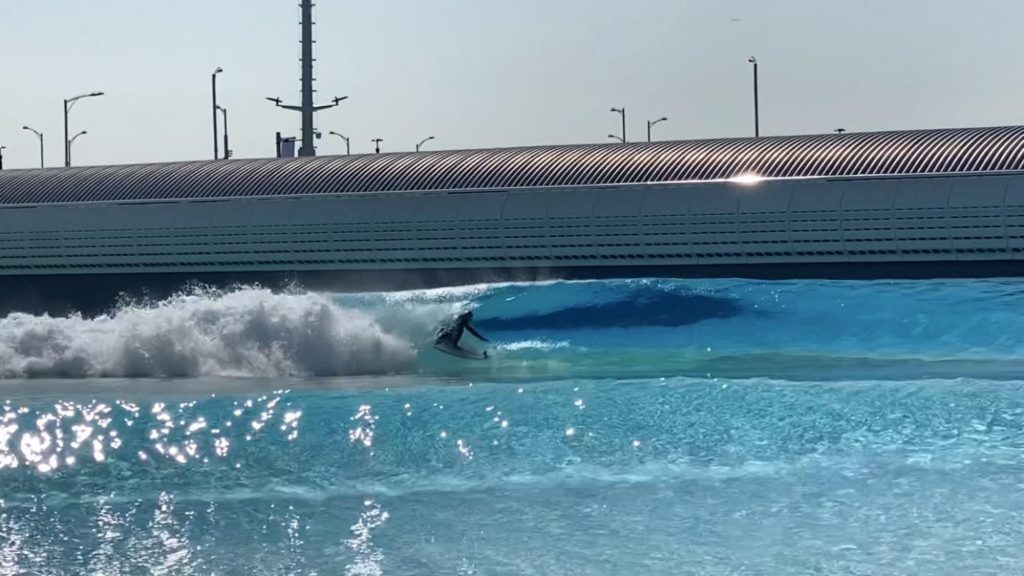
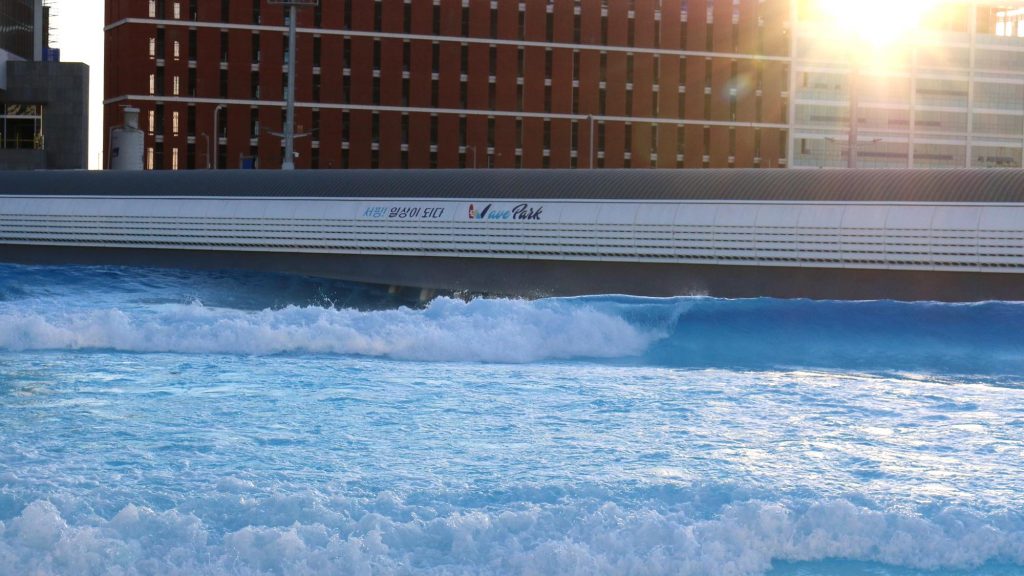
You told us a story about how the surf contest at Wave Park has helped the scene in Korea a lot.
I was surprised to see the surfers in Korea improve so much after Wave Park was built. And there’s a new word coined for surfers who have never surfed in the ocean but only at this chlorinated wave pool: ‘Min-Mool surfers’. ‘Min Mool’ means tap water in Korean, so it has been coined to signify a surfer who has only surfed at a wave pool. Korea is now in the childhood stage, slowly maturing its surf culture and developing its own chlorine surfers, culminating in its first-ever surf league. The league lasted the entire summer, and surfers got to compete for seven rounds which took two months because of each round was held only during weekends, while surfboards, longboards and beginner sessions took turns occupying the Cove. The league wasn’t boring at all because you only get better and better as you reach the final rounds with stiff competition and friends whom you’ve made in the water.
Wave Park is also the only surf park in the world with heated water, right?
Surprisingly it is the only one in the world. I know that true surfers can surf even in the winter cold but why put up with the cold when this advanced technology is now available in a wave pool? The idea came from the Chairman, and he wondered whether this would work or not. So, he asked me and I tried for myself surfing in 5-degree Celsius water. It’s a very Korean thing to do whether bathing or eating. We Koreans do love hot steam whether from a hot soup or a hot tub. So, there are some fancy hotels heating their outdoor swimming pools during the winter, with guests lounging in the hot spring in their swimsuits while their faces are exposed out of the water facing the cold wind. That’s what he imagined when heating the water but it turned out that the blistering cold made it lukewarm water. In the beginning, it steamed like a hot spring and surfers felt so warm when heated by 21-22 degrees. But because of the high cost of heating, the water remained at around 15 degrees Celsius which is still good enough compared to non-heated winter water. So, my answer to him was yes, it would work for winter surfers. And he was right. If you are visiting Wave Park during the wintertime, get close to the number 3 painted along the wall of the line-up. That’s the hot spot where the warm water comes out.
Related Coverage
